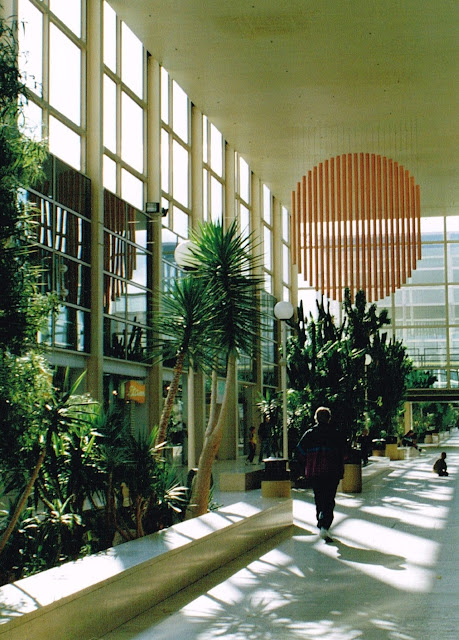 |
| Midsummer Arcade in 1990, with a sculpture,Circle of Light, by Liliane Lijn above the planting |
I spent the years from 1975 to 1993 living in Milton Keynes, the largest New Town ever built in Britain. I was engaged on several occasions to photograph the Milton Keynes Shopping Building, which was the largest indoor shopping centre in Europe at the time, as well as the most beautiful. In Britain, shopping centres only became called malls in the 1990's when the influence of American shopping malls began to creep across to this side of the Atlantic.
 Milton Keynes Shopping Centre was designed and built for the Milton Keynes Development Corporation in the 1970's, in the Modernist style influenced by Mies van de Rohe. It has high, bright indoor streets with huge, high level windows allowing daylight to stream in. As well as more than adequate space for all the high street retail chains, the original building included restaurants, pubs, a wine bar, two large outdoor squares, a huge indoor hall, two department stores, two supermarkets, a market hall, an arcade of small, low rental, specialist shops and a traditional outdoor market. The structure was fed by bus routes on either side and surrounded by extensive ground level parking, which was initially free though charges were soon introduced.
Milton Keynes Shopping Centre was designed and built for the Milton Keynes Development Corporation in the 1970's, in the Modernist style influenced by Mies van de Rohe. It has high, bright indoor streets with huge, high level windows allowing daylight to stream in. As well as more than adequate space for all the high street retail chains, the original building included restaurants, pubs, a wine bar, two large outdoor squares, a huge indoor hall, two department stores, two supermarkets, a market hall, an arcade of small, low rental, specialist shops and a traditional outdoor market. The structure was fed by bus routes on either side and surrounded by extensive ground level parking, which was initially free though charges were soon introduced. Streets and squares were floored with Italian travertine and enhanced with long, low planters, providing both seating and space for the most spectacular displays of indoor greenery in any shopping centre. The service road runs above the shopping level, keeping delivery vehicles completely separate and hidden from shoppers. The Centre was opened in 1979 by Margaret Thatcher and was an immediate success, attracting daily shoppers from as far away as Birmingham. A visiting planner from Poland which was then in Communist Eastern Europe described it as a cathedral to capitalism.
Strict development control initially kept most retailers in check, so they could not interrupt the light and flow of the extensive public spaces throughout the building. Quality and individuality was encouraged in the fitting out of units. This degree of tasteful control was eventually whittled away, to be replaced by upfront commercialism and the subsequent extensions have made the building even longer, so it is still the longest in Europe, if no longer the largest. The newer additions lack the design purity of the original.
Milton Keynes was the first shopping centre in the UK designed from the outset with the needs of the disabled in mind. Parking, pavements, squares, markets and internal avenues were all on one level, shop entrances had no steps and the doors to the building's many external entrances were wide and automated with controls at low levels for wheelchair users. This idea was very new at the time. There was also a mobility centre where wheelchairs, scooters and other aids could be borrowed for use in the centre.
The centre achieved fame across the Atlantic when it was used in the 1980's during filming of the Superman movies. Its modernist style was what the film producers needed, they thought it looked far more like Superman's ultra modern city of Metropolis than anywhere in the USA. They even enquired whether the roof of Middleton Hall could be opened for a certain scene they wanted to shoot. The answer was no, so they had to use computer effects to open the roof instead.
 |
| Middleton Hall houses fairs, exhibitions, concerts, trade shows and a huge winter wonderland each Christmas. |
In spite of later, unsympathetic developments the original Milton Keynes shopping building remains a beautiful, modernist structure and is the only shopping centre to have a Grade II listing . This was first mooted in 2002 and finally granted in 2010, despite continuous and vehement objections from the current owners, who whined that this would stop their plans for 'future evolution and growth'. (see Guardian article http://www.guardian.co.uk/artanddesign/2010/jul/16/milton-keynes-shopping-centre-grade-listed ). Hopefully the Grade II listed status will help to restrain the developmental urges of the owners, who seem more interested in making vast sums of money for themselves than in maintaining the beauty of the building which everyone can enjoy. They need to realise that a cathedral to capitalism is more uplifting and much more significant than a mere shopping centre!

.jpg)
+Fagins.jpg)
No comments:
Post a Comment